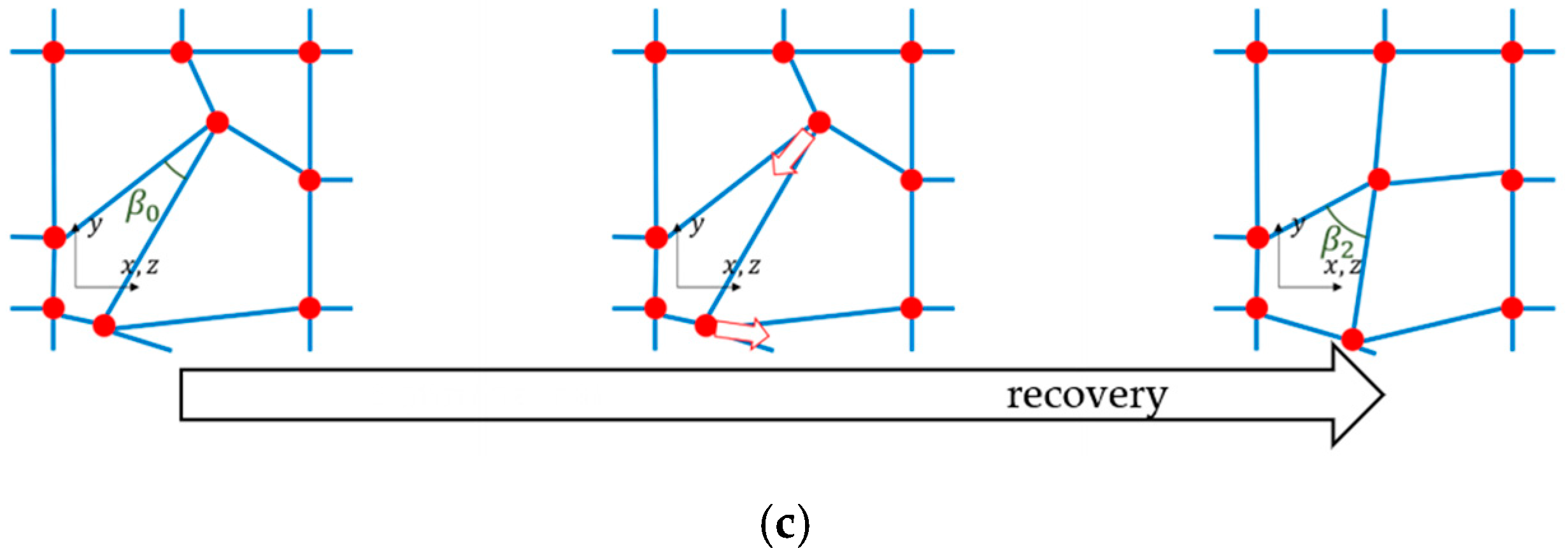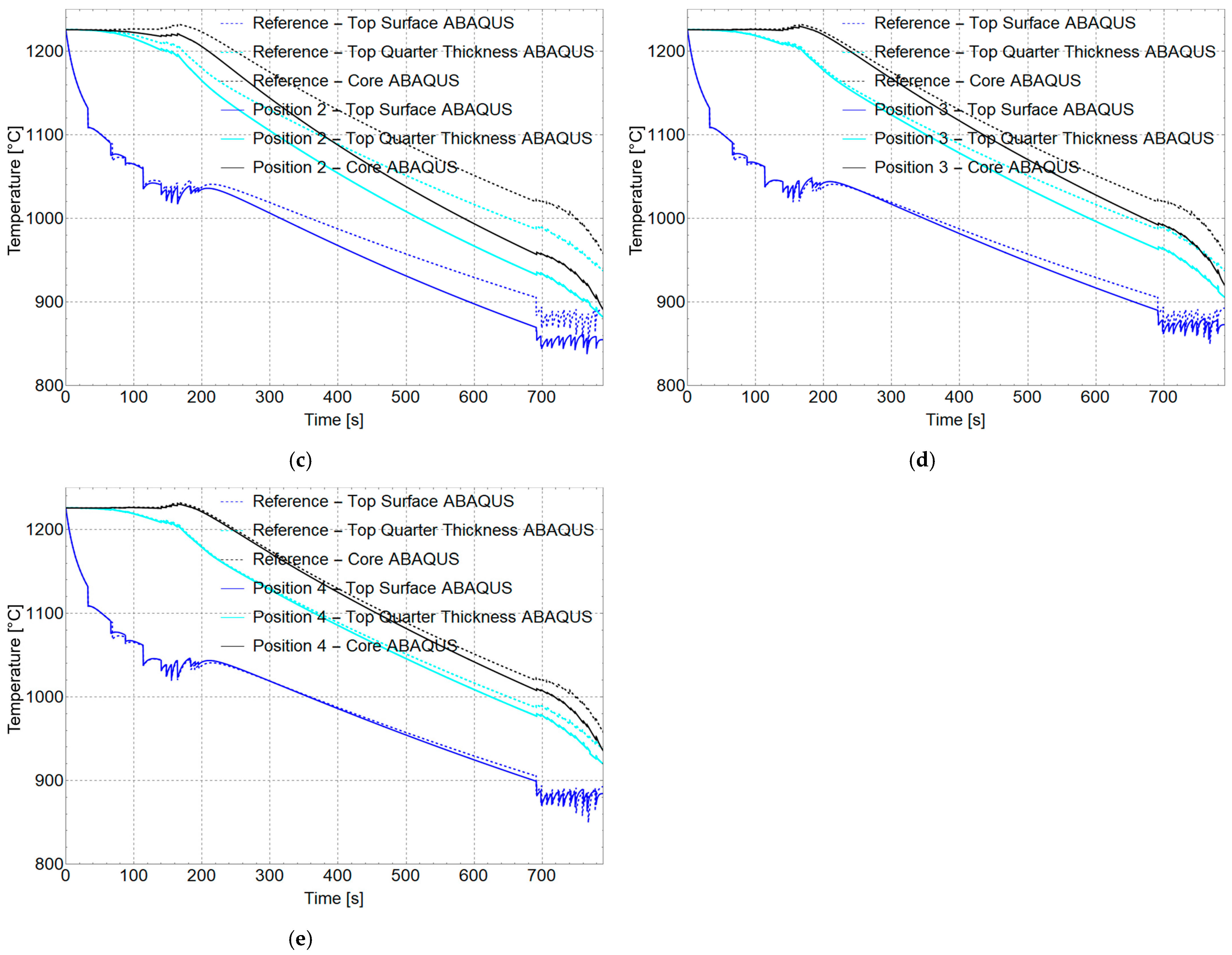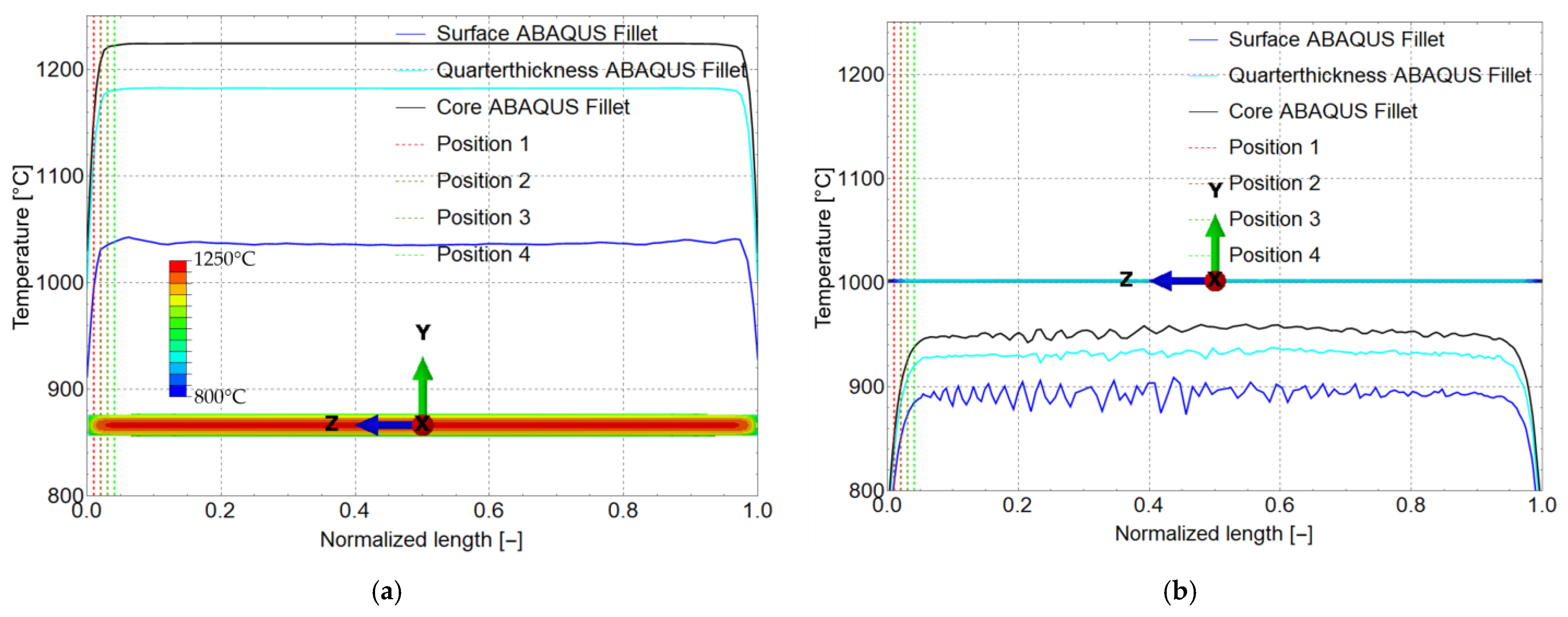Modular Finite Element Modeling of Heavy Plate Rolling Processes Using Customized Model Reduction Approaches
Abstract
1. Introduction
2. Modular Modeling and Virtual Process Route
2.1. Simulation Modules
2.2. Interaction Modules
3. Application, Correlation with Measured Process Data, and Discussion
3.1. Material, Thermo-Physical, and Tribological Data Utilized in the Use Case
3.2. Evolution of Temperature
3.3. Thermal Asymmetry
4. Conclusions and Outlook
Author Contributions
Funding
Data Availability Statement
Conflicts of Interest
References
- Jo, S.Y.; Hong, S.; Han, H.N.; Lee, M. Modeling and Simulation of Steel Rolling with Microstructure Evolution: An Overview. Steel Res. Int. 2023, 94, 2200260. [Google Scholar] [CrossRef]
- Rout, M.; Pal, S.K.; Singh, S.B. Finite Element Modeling of Hot Rolling: Steady- and Unsteady-State Analyses. In Computational Methods and Production Engineering; Davim, J.P., Ed.; Woodhead Publishing: Sawstoun, UK, 2017; pp. 83–124. [Google Scholar]
- Mistry, G.D.; Judal, K.B. Literature review of the stress, strain and separating force evaluation during hot bar rolling of different types of steels. Mater. Today Proc. 2022, 57, 636–642. [Google Scholar] [CrossRef]
- Sims, R.B. The calculation of roll force and torque in hot rolling mills. Proc. Inst. Mech. Eng. 1954, 168, 191. [Google Scholar] [CrossRef]
- Maccagno, T.M.; Jonas, J.J.; Hodgson, P.D. Spreadsheet Modelling of Grain Size Evolution during Rod Rolling. ISIJ Int. 1996, 36, 720. [Google Scholar] [CrossRef]
- Siciliano, F.; Minami, K.; Maccagno, T.M.; Jonas, J.J. Mathematical modeling of the mean flow stresses, fractional softening and grain size during the hot strip rolling of C-Mn steels. ISIJ Int. 1996, 36, 1500. [Google Scholar] [CrossRef]
- Galantucci, L.M.; Tricarico, L. Thermo-mechanical simulation of a rolling process with an FEM approach. J. Mater. Process. Technol. 1999, 92–93, 494. [Google Scholar] [CrossRef]
- Wisselink, H.H.; Huétink, J. 3D FEM simulation of stationary metal forming processes with applications to slitting and rolling. J. Mater. Process. Technol. 2004, 148, 328. [Google Scholar] [CrossRef]
- Deng, W.; Zhao, D.W.; Qin, X.M.; Du, L.X.; Gao, X.H.; Wang, G.D. Simulation of central crack closing behavior during ultra-heavy plate rolling. Comput. Mater. Sci. 2009, 47, 439–447. [Google Scholar] [CrossRef]
- Parteder, E.; Zeman, K.; Du, H.; Grill, R. Recalculation of Flow Stresses from Industrial Process Data for Heavy Plate Rolling Using a 2D Finite Element Model. Steel Res. 2012, 83, 124–130. [Google Scholar] [CrossRef]
- González-Castillo, A.C.; Cruz-Rivera, J.d.J.; Ramos-Azpeitia, M.O.; Garnica-González, P.; Garay-Reyes, C.G.; Pacheco-Cedeño, J.S.; Hernández-Rivera, J.L. 3D-FEM Simulation of Hot Rolling Process and Characterization of the Resultant Microstructure of a Light-Weight Mn Steel. Crystals 2021, 11, 569. [Google Scholar] [CrossRef]
- Klančnik, G.; Foder, J.; Bradaškja, B.; Kralj, M.; Klančnik, U.; Lalley, P.; Stalheim, D. Hot Deformation Behavior of C-Mn Steel with Incomplete Recrystallization during Roughing Phase with and without Nb Addition. Metals 2022, 12, 1597. [Google Scholar] [CrossRef]
- Renault, C.; Churyumov, A.; Pozdniakov, A.V.; Churyumova, T.A. Microstructure and hot deformation behavior of FeMnAlCMo steel. J. Mater. Res. Technol. 2020, 9, 4440–4449. [Google Scholar] [CrossRef]
- Zhou, J.; Yu, Z.; Chen, J.; Wu, S.; Wu, K.; Pan, L. The Performance of Niobium-Microalloying Ultra-High-Strength Bridge Cable Steel during Hot Rolling. Materials 2024, 17, 1259. [Google Scholar] [CrossRef] [PubMed]
- Cui, S.; Gu, G.; Shi, C.; Xiao, G. Variations in microstructure and mechanical properties along thickness direction in a heavy high strength low alloy steel plate. J. Mater. Res. Technol. 2023, 26, 9190–9202. [Google Scholar] [CrossRef]
- Li, H.; Li, T.; Gong, M.; Wang, Z.; Wang, G. Finite Element Analysis of Dynamic Recrystallization of Casting Slabs during Hot-Core Heavy Reduction Rolling Process. Metals 2020, 10, 181. [Google Scholar] [CrossRef]
- Li, H.; Gong, M.; Li, T.; Wang, Z.; Wang, G. Effects of hot-core heavy reduction rolling during continuous casting on microstructures and mechanical properties of hot-rolled plates. J. Mater. Process. Technol. 2020, 283, 116708. [Google Scholar] [CrossRef]
- Li, R.; Li, H.; Ning, X.; Li, T.; Wie, H.; Wang, G. Temperature Influence on Section Uniformity of Casting Steel Rolled with the Hot-Core Heavy Reduction Rolling Process and Traditional Hot Rolling Process. J. Mater. Eng. Perform. 2022, 31, 7391–7401. [Google Scholar] [CrossRef]
- Li, T.; Gao, P.; Li, H.; Tang, X.; Wang, X.; Ren, J.; Wang, Z. Comparison of Dynamic Recrystallization in Blooms between Conventional Rolling and Hot-Core Heavy Reduction Rolling Process. Steel Res. 2023, 94, 2300043. [Google Scholar] [CrossRef]
- Ning, Z.; Li, X.; Liu, H.; Cai, Q.; Yu, W. Experimental and Simulation Study on the Effect of Reduction Pretreatment on the Void Healing of Heavy Plate. Metals 2022, 12, 400. [Google Scholar] [CrossRef]
- Liu, Y.; Li, Y.; Wang, Z.; Liu, Y.; Wang, T.; Huang, Q.; Wang, T. Deformation mechanism and microstructure evolution in stainless steel clad plate of longitudinal corrugated hot rolling. J. Mater. Process. Technol. 2023, 316, 117957. [Google Scholar] [CrossRef]
- Cheng, Y.; Liu, W.; Wang, T.; Li, T.; Huang, Q. Study on the effects of initial temperature and thickness ratio of component metals on the preparation of aluminum/steel clad plates by the new different temperature rolling method. J. Manuf. Process. 2023, 95, 229–241. [Google Scholar] [CrossRef]
- Guo, X.; Ren, Z.; Chai, Z.; Wang, T.; Huang, Q. Research on microstructure and mechanical properties of TC4/304 clad plates by asymmetric rolling with local strong stress. Mater. Sci. Eng. A 2024, 893, 146166. [Google Scholar] [CrossRef]
- Nemetz, A.W.; Parteder, E.; Reimer, P.; Kaltenbrunner, T.; Heise, B.; Lekue, J.; Gross, T.; Egger, R.; Zeman, K. Towards a 2D/3D FE-Based Digital Twin for the Approximation of Metrologically Inaccessible Dynamic Fields of State Variables During Heavy Plate Rolling. Steel Res. 2023, 94, 2200672. [Google Scholar] [CrossRef]
- Han, J.; Cheng, Q.; Hu, P.; Xing, H.; Li, S.; Ge, S.; Hua, X.; Hu, B.; Zhang, W.; Wang, K. Finite Element Analysis of Large Plastic Deformation Process of Pure Molybdenum Plate during Hot Rolling. Metals 2023, 13, 101. [Google Scholar] [CrossRef]
- Hwang, J.-K. Thermal Behavior of a Rod during Hot Shape Rolling and Its Comparison with a Plate during Flat Rolling. Processes 2020, 8, 327. [Google Scholar] [CrossRef]
- Li, Y.H.; Krzyzanowski, M.; Beynon, J.H.; Sellars, C.M. Physical simulation of interfacial conditions in hot forming of steels. Acta Metall. Sin. 2000, 13, 359–368. [Google Scholar]
- Longère, P.; Dragon, A. Evaluation of the inelastic heat fraction in the context of microstructure-supported dynamic plasticity modelling. Int. J. Eng. 2008, 35, 992–999. [Google Scholar] [CrossRef]
- Pietschnig, C.; Steinboeck, A.; Kugi, A. Optimal control of motion and camber of steel plates in a multi-pass reversing rolling process. IFAC-PapersOnLine 2022, 55, 180–185. [Google Scholar]
- Ding, Y.; Zhu, Q.; Le, Q.; Zhang, Z.; Bao, L.; Cui, J. Analysis of temperature distribution in the hot plate rolling of Mg alloy by experiment and finite element method. J. Mater. Process. Technol. 2015, 225, 286–294. [Google Scholar] [CrossRef]
- Lekue, J.; Reimer, P.; Parteder, E.; Nemetz, A.W.; Kaltenbrunner, T.; Heise, B.; Falkner, S.; Gross, T.; Egger, R.; Zeman, K. Characterization of thermomechanical effects in heavy plate hot rolling as a function of process settings. In Proceedings of the METEC & 6th ESTAD 2023, Düsseldorf, Germany, 12–16 June 2023. [Google Scholar]
- Cao, J.; Wang, Y.; Huang, S.; Wang, C. Optimized shearing strategy for heavy plate based on contour recognition. J. Iron Steel Res. Int. 2023, 30, 1821–1833. [Google Scholar] [CrossRef]











| Pass | Time [s] | Plate Velocity [mm/s] | Plate Thickness after Pass [mm] | Measured Fillet Surface Temperature [°C] |
|---|---|---|---|---|
| 1 | 69 | 718 | 255 | 1091 |
| 2 | 88 | 2012 | 242 | - |
| 3 | 140 | 1885 | 215 | 1040 |
| 4 | 148 | 1938 | 187 | - |
| 5 | 155 | 1961 | 158 | - |
| 6 | 164 | 716 | 134 | 1043 |
| 7 | 184 | 2195 | 130 | - |
| 8 | 189 | 2225 | 128 | - |
| 9 | 196 | 2196 | 127 | - |
| 10 | 691 | 2480 | 114 | - |
| 11 | 699 | 2367 | 106 | - |
| 12 | 707 | 2396 | 99 | - |
| 13 | 715 | 2184 | 92 | - |
| 14 | 724 | 2172 | 86 | - |
| 15 | 732 | 2141 | 80 | - |
| 16 | 741 | 2151 | 74 | - |
| 17 | 750 | 2150 | 68 | - |
| 18 | 759 | 2147 | 62 | 880 |
| 19 | 768 | 2145 | 57 | 875 |
| 20 | 778 | 3044 | 51 | 882 |
| Pass | Plate Length after Pass [mm] | Actual Offset from the Head Surface | |||
|---|---|---|---|---|---|
| Position 1 [mm] | Position 2 [mm] | Position 3 [mm] | Position 4 [mm] | ||
| slab | 3460 | 36 | 71 | 107 | 142 |
| 1 | 3686 | 38 | 76 | 114 | 152 |
| 2 | 1794 | 18 | 37 | 55 | 74 |
| 3 | 2022 | 21 | 42 | 62 | 83 |
| 4 | 2327 | 24 | 48 | 72 | 96 |
| 5 | 2741 | 28 | 56 | 85 | 113 |
| 6 | 3225 | 33 | 66 | 99 | 133 |
| 7 | 3824 | 39 | 79 | 118 | 157 |
| 8 | 3897 | 40 | 80 | 120 | 160 |
| 9 | 3913 | 40 | 80 | 121 | 161 |
| 10 | 4353 | 45 | 90 | 134 | 179 |
| 11 | 4694 | 48 | 97 | 145 | 193 |
| 12 | 5012 | 52 | 103 | 155 | 206 |
| 13 | 5371 | 55 | 110 | 166 | 221 |
| 14 | 5763 | 59 | 118 | 178 | 237 |
| 15 | 6199 | 64 | 127 | 191 | 255 |
| 16 | 6700 | 69 | 138 | 207 | 276 |
| 17 | 7288 | 75 | 150 | 225 | 300 |
| 18 | 7970 | 82 | 164 | 246 | 328 |
| 19 | 8766 | 90 | 180 | 270 | 360 |
| 20 | 9727 | 100 | 200 | 300 | 400 |
| Slab | Work Roll | ||||
|---|---|---|---|---|---|
| Length [mm] | Width [mm] | Thickness [mm] | Initial Temperature [°C] | Diameter [mm] | Temperature [°C] |
| 3460 | 1707 | 273 | 1226 | 1000 | 100 |
Disclaimer/Publisher’s Note: The statements, opinions and data contained in all publications are solely those of the individual author(s) and contributor(s) and not of MDPI and/or the editor(s). MDPI and/or the editor(s) disclaim responsibility for any injury to people or property resulting from any ideas, methods, instructions or products referred to in the content. |
© 2024 by the authors. Licensee MDPI, Basel, Switzerland. This article is an open access article distributed under the terms and conditions of the Creative Commons Attribution (CC BY) license (https://creativecommons.org/licenses/by/4.0/).
Share and Cite
Nemetz, A.W.; Parteder, E.; Reimer, P.; Kaltenbrunner, T.; Heise, B.; Lekue, J.; Gross, T.; Falkner, S.; Egger, R.; Zeman, K. Modular Finite Element Modeling of Heavy Plate Rolling Processes Using Customized Model Reduction Approaches. Metals 2024, 14, 444. https://doi.org/10.3390/met14040444
Nemetz AW, Parteder E, Reimer P, Kaltenbrunner T, Heise B, Lekue J, Gross T, Falkner S, Egger R, Zeman K. Modular Finite Element Modeling of Heavy Plate Rolling Processes Using Customized Model Reduction Approaches. Metals. 2024; 14(4):444. https://doi.org/10.3390/met14040444
Chicago/Turabian StyleNemetz, Andreas W., Erik Parteder, Paula Reimer, Thomas Kaltenbrunner, Bodo Heise, Jagoba Lekue, Thomas Gross, Stefan Falkner, Rupert Egger, and Klaus Zeman. 2024. "Modular Finite Element Modeling of Heavy Plate Rolling Processes Using Customized Model Reduction Approaches" Metals 14, no. 4: 444. https://doi.org/10.3390/met14040444
APA StyleNemetz, A. W., Parteder, E., Reimer, P., Kaltenbrunner, T., Heise, B., Lekue, J., Gross, T., Falkner, S., Egger, R., & Zeman, K. (2024). Modular Finite Element Modeling of Heavy Plate Rolling Processes Using Customized Model Reduction Approaches. Metals, 14(4), 444. https://doi.org/10.3390/met14040444









